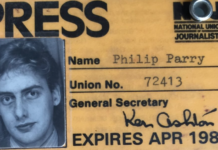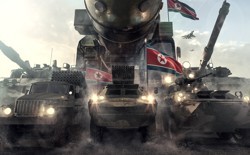- Massage table part two - 18th December 2025
- Massage table part one - 17th December 2025
- Strictly poison part two - 16th December 2025
Notwithstanding the Trump administration’s pledge that it will not allow North Korea to obtain nuclear weapons that can reach parts of the United States as well as its assertion that all options remain on the table when dealing with the regime in Pyongyang, the options to deal with North Korea are both limited and fraught.
The “self-restraint” Brooks spoke of has been in place since the 1950-53 Korean War ended in an armistice—but not a peace treaty—which means the Korean Peninsula is still technically in a state of war. The U.S. has about 30,000 troops in South Korea that serve as a buffer in the event of North Korean belligerence (a further 50,000 troops in Japan protect that country). The U.S. conducts regular military exercises with South Korea, sells it weapons, and is its main ally. This, as one might imagine, makes North Korea, which until recently was labeled the world’s only Stalinist state, insecure. It has repeatedly called the joint U.S.-South Korean military exercises a provocation, an act of war, or a pretext for an invasion. It has also developed a sophisticated missile and nuclear-weapons program that dialogue, economic incentives, or sanctions have done little to deter. The North also has an array of artillery, medium-range missiles, and plutonium bombs that are aimed at South Korea and farther afield, all but ensuring any departure from U.S. and South Korean “self-restraint” will result in unprecedented bloodshed.
North Korea’s stated goal is an ICBM armed with a nuclear warhead that can reach the United States—a development most experts say is only a matter of time. Indeed, its missile test Tuesday was its most successful ever, and experts say the Hwasong-14 missile could reach Alaska. Speaking last week at the Aspen Ideas Festival, which is co-hosted by The Aspen Institute and The Atlantic, General David Petraeus, the former CIA director, said North Korean leader Kim Jong Un “could have a nuclear device that could actually strike Los Angeles or San Francisco” during President Trump’s first term.
Indeed, the U.S. has few options in dealing with North Korea: most of them expected to result in a North Korean military response that could wreak havoc on South Korea, Japan, and U.S. military assets in the region. As Mark Bowden wrote in last month’s Atlantic, the choices facing the U.S. aren’t good. They range from a U.S. first strike against the North to more limited military action; from the decapitation of the Kim regime to acceptance of the North’s nuclear ambitions.
The first option, Bowden wrote, “would likely trigger one of the worst mass killings in human history” as the North responds to a U.S. strike; the second, a limited strike, could prompt a counterattack, resulting in “another, perhaps more devastating, American blow” that would persuade Pyongyang that the U.S. is serious about not allowing it to develop nuclear weapons that can reach the U.S. mainland. But as Bowden points out:
The problem with trying to turn the screws on Pyongyang is that once the shooting starts, containing it may be extremely difficult. Any limited strike would almost certainly start an escalating cycle of attack/counterattack. Owing to miscalculation or misunderstanding, it could readily devolve into the full-scale peninsular war described earlier. For the strategy to work, Pyongyang would have to recognize America’s intent from the outset—and that is not a given. The country has a hair-trigger sensitivity to threat, and has been anticipating a big American invasion for more than half a century.
The third option, decapitation, would not only have to rely on someone inside Kim’s inner circle cooperating with the U.S., but also on China’s willingness to permit the geopolitical chaos that would follow such an event. Also, as Bowden points out: “Given the reverence accorded Kim, his sudden death might trigger an automatic military response. And what guarantees are there that his replacement wouldn’t be worse?” Which brings us to the final option: acceptance of a North Korea that possesses nuclear weapons that can reach the U.S.—a situation that, despite President Trump tweeting it “will not happen,” could be the policy the U.S. adopts. Kim’s use of such weapons would almost certainly lead to his country’s annihilation, a threat that would be a powerful deterrent to his regime.
But many of the arguments in favor of action against North Korea are based on the idea that Pyongyang is developing the capacity to target the United States in order to attack the U.S. It could equally be true that Pyongyang views this ability as a tool of deterrence against a potential U.S. attack. After all, the North points missiles at Seoul and can target U.S. facilities in the region, but does not—because of the potential consequences. In the past, the North has used such moments to seek negotiations with the West so some of the international sanctions in place against it can be eased. Indeed, it provided a similar opening on Wednesday.
An article in Chosun Sinbo, the Tokyo-based Korean newspaper that is seen as a mouthpiece for the North Korean regime, said: “The ongoing nuclear showdown between Pyongyang and Washington has entered into its final phase with the North’s successful Hwasong-14 ICBM test-fire, and now avoiding armed conflict and seeking ways to find a clue to settle it via diplomatic negotiations have become a pressing issue that the international community can no longer turn away from.”
It added: “Any military action against a country with nuclear retaliation capabilities will literally cause a destructive consequence”—a position both North Korea and the U.S. agree on.









